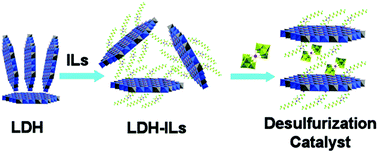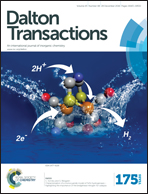A multicomponent assembly approach for the design of deep desulfurization heterogeneous catalysts†
Abstract
Deep desulfurization is a challenging task and global efforts are focused on the development of new approaches for the reduction of sulfur-containing compounds in fuel oils. In this work, we have proposed a new design strategy for the development of deep desulfurization heterogeneous catalysts. Based on the adopted design strategy, a novel composite material of polyoxometalate (POM)-based ionic liquid-grafted layered double hydroxides (LDHs) was synthesized by an exfoliation/grafting/assembly process. The structural properties of the as-prepared catalyst were characterized using FT-IR, XRD, TG, NMR, XPS, BET, SEM and HRTEM. The heterogeneous catalyst exhibited high activity in deep desulfurization of DBT (dibenzothiophene), 4,6-DMDBT (4,6-dimethyldibenzothiophene) and BT (benzothiophene) at 70 °C in 25, 30 and 40 minutes, respectively. The catalyst can be easily recovered and reused at least ten times without obvious decrease of its catalytic activity. Such excellent sulfur removal ability as well as the cost efficiency of the novel heterogeneous catalyst can be attributed to the rational design, where the spatial proximity of the substrate and the active sites, the immobilization of ionic liquid onto the LDHs via covalent bonding and the recyclability of the catalyst are carefully considered.


 Please wait while we load your content...
Please wait while we load your content...